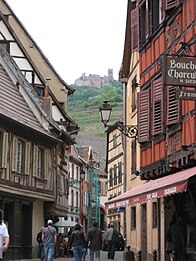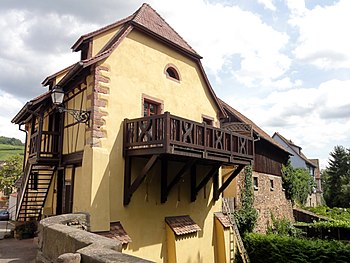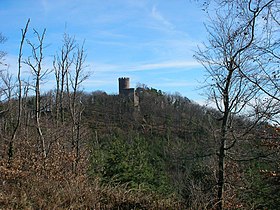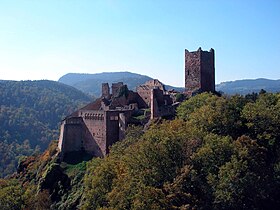Ribeauvillé
| Ribeauvillé | ||
|---|---|---|

|
|
|
| region | Grand Est | |
| Department | Haut-Rhin | |
| Arrondissement | Colmar-Ribeauvillé | |
| Canton | Sainte-Marie-aux-Mines | |
| Community association | Pays de Ribeauvillé | |
| Coordinates | 48 ° 12 ' N , 7 ° 19' E | |
| height | 188-989 m | |
| surface | 32.21 km 2 | |
| Residents | 4,729 (January 1, 2017) | |
| Population density | 147 inhabitants / km 2 | |
| Post Code | 68150 | |
| INSEE code | 68269 | |
| Website | http://www.ribeauville.net/ | |
 Aerial view |
||
Ribeauvillé ( German Rappoltsweiler ; Alsatian Rappschwihr ) is a French town with 4,729 inhabitants (January 1, 2017) in the Haut-Rhin department in the Grand Est region (until 2015 Alsace ). The city belongs to the canton of Sainte-Marie-aux-Mines and is the seat of the community association Pays de Ribeauvillé . It was until December 31, 2014 seat of the sub-prefecture (French sous-préfecture ) of the Arrondissement Ribeauvillé .
geography
Ribeauvillé is located 15 kilometers northwest of Colmar on the eastern edge of the Vosges at the exit of the Strengbach valley at 185 m above sea level. NHN. The municipality belongs to the Ballons des Vosges Regional Nature Park and stretches from the Rhine plain over the foothills zone, which is characterized by wine cultures , to the summit of the 992 m high Taennchel in the west. The Alsace Wine Route (Route des Vins d'Alsace) runs through the city . A few kilometers to the east is the Ribeauvillé train station on the Strasbourg – Basel railway line .
history
Ribeauvillé is first mentioned in 759 as Ratbaldouilare ; further mentions are Ratbertouillare (768), Ratpoldesuilare (896) and Rapolswilre (1162). The French place name is also mentioned in the late Middle Ages (1344 Ribauvillers ). Ribeauvillé is first attested as a town in 1290. The rulers of Rappoltstein , who exercised the rights of the city lords until 1673, have been documented since 1038 . After their extinction, the rule of Rappoltstein (Ribeaupierre) and with it the city fell to Pfalz-Birkenfeld , from 1734 Pfalz-Birkenfeld-Zweibrücken .
In 1680/81 the city and the rule of Rappoltstein came under the sovereignty of France from the Holy Roman Empire , but the French administration was only introduced in the course of the dissolution of feudal rule with the French Revolution in 1789 and this was sanctioned under international law in 1801.
On January 13, 1835, a memorial plaque for the local theologian Philipp Jacob Spener was installed in the Protestant church . In 1861 Rappoltsweiler had 7181 inhabitants. Around 1900 Rappoltsweiler had one Protestant and two Catholic churches, a synagogue , a secondary school , a district court and a forest ranger's office .
From 1871 to 1918 the city was the administrative seat of the Alsace-Lorraine district of Rappoltsweiler .
Demographics
| year | population | Remarks |
|---|---|---|
| 1872 | 7146 | |
| 1890 | 5920 | |
| 1905 | 5986 | mostly Catholic residents, according to other data, 5990 residents |
| 1910 | 5846 |
| year | 1962 | 1968 | 1975 | 1982 | 1990 | 1999 | 2007 | 2017 |
| Residents | 4314 | 4137 | 4282 | 4506 | 4774 | 4929 | 4916 | 4729 |
Culture and sights
Cityscape
The old town of Ribeauvillé is characterized by numerous houses from the 16th and 17th centuries. Dominant medieval monuments are the parish church of St.-Grégoire-le-Grand and the butcher's tower ( Tour des Bouchers ; both from the 13th century). The place is dominated by the three castle ruins Ulrichsburg (ancestral seat of the Lords of Rappoltstein ), Girsberg and Hohrappoltstein .
St. Gregory Church
The St. Gregory Church is dedicated to St. Gregory the Great (540–604) and dates back to the 13th century. The building is Gothic in style and influenced by the Rhenish school. The church has a main nave and two side aisles . Some of its architectural features are classified as historical monuments. The two church portals on the side and at the back date from the 14th century. The rear portal shows a bas-relief in the tympanum with the seated Virgin, who is carrying Jesus on her knees. Below is the crucified Savior, on his right with Mary and St. Catherine with their instruments of torture, wheel and sword. To his left are St. John the Baptist , carrying the Lamb of God , and John the Evangelist . On either side of the portal inside there are two tombstones on the wall from the end of the 18th century. The organs of the church come from the Temple Neuf in Strasbourg and were created by the organ builder Rinck in 1700, completed by Legros in 1702 and checked by Andreas Silbermann in 1708. They contain some of the oldest Alsatian organ pipes - after those of the Bouxwiller church . The musical instrument was completely restored in 1984 by the organ builder Dieter Kern . The baroque style polychrome organ case enhances the splendid impression of the organs.
Château du Girsberg
The castle Girsberg , French Château du Girsberg , is a ruin of a Spur castle to 528 meters at a vertical towering granite cliffs above the village of Ribeauvillé. Built from 1250 by the Lords of Rappoltstein (French: Ribeaupierre) and rebuilt in 1288 after being destroyed by lightning, it is first mentioned in documents. In 1304 the knights of Girsberg took the castle as a fief and gave it its name. The castle was on 11 June 1422 at a feud I of Maximin Smassmann of Rappoltstein besieged , taken and killed by Guillaume Girsberg. The core castle was enlarged in the 15th century with a new building, the keep was raised and a Romanesque residential building was built. After the Rappoltstein family died out at the end of the 17th century, the complex was abandoned and left to decay. The existing structure was restored in the 1990s .
Château du Haut-Ribeaupierre
The castle Hohrappoltstein , French Château du Haut-Ribeaupierre , is the ruin of a hilltop castle at an altitude of 645 meters above Ribeauvillé. In the 13th century, a fortification from the High Middle Ages was built over by today's castle , first mentioned in a document in 1254. Owned by the diocese of Bamberg and later the diocese of Basel , the complex was given to the von Rappoltstein family as a fief until they died out in 1673. The castle was no longer inhabited and was a half ruin. Today it is owned by the French state and the French national forest authority ( French Office national des forêts (ONF) ) and closed to visitors due to the risk of collapse. The castle is surrounded by ramparts and ditches and is divided into a so-called upper castle with keep, the lower castle outer bailey and a bastion on the south flank with a second gate .
Château de Saint-Ulrich
The rock castle Sankt Ulrich , French Château de Saint-Ulrich , is a ruin at a height of 510 meters and the largest of the three nearby Rappoltsteiner castles. Between the square keep in the north and a fortified tower in the south there are residential buildings and a chapel from 1435. A kennel and the knight's hall with nine Romanesque twin windows have been preserved. After an initial construction phase in the 11th century, the castle was completed in 1289 and first mentioned in a document in 1298. The castle fell into disrepair after the Thirty Years' War and the ruins are now an impressive example of the military architecture of medieval Alsace.
Notre-Dame de Dusenbach
Notre-Dame de Dusenbach is a Capuchin monastery and place of pilgrimage near Ribeauvillé. After returning from the Damiette crusade , Egenolph II von Rappoltstein, liege lord of the Basel bishop, settled as a hermit in Dusenbach in 1221 to recover from the rigors of the war. He had brought a statue of the Virgin with him from his travels and had a chapel built in Dusenbach as thanks for his happy return home. Around 1260 the brothers Ulrich II and Heinrich I von Rappoltstein, nephews of Egenolph II, built a second chapel next to the first, they stand one behind the other on a rock and are Gothic in character. Anselm II von Rappoltstein was arrested in 1296 after the unsuccessful uprising against King Adolf von Nassau and vowed to build a new chapel in Dusenbach if he were released. This happened at Mariae Candlemas in 1297, after which he built a third chapel in the neo-Gothic style. In 1484, after a pilgrimage to the Holy Land, Maximin II von Rappoltstein donated a Way of the Cross with a Calvary and in 1494 replaced the statue of the Virgin Mary, destroyed by the French in 1360, with a wooden Mater Dolorosa carrying Christ in her arms. The chapels were destroyed during the French Revolution in 1791. The almost faithful reconstruction was carried out in 1892 by the Strasbourg Bishop Adolf Fritzen . In 1896 the bishop inaugurated a new way of the cross, the small station chapels of which were restored in 1921/1922 and 2001/2004. A small community of Capuchins lived in Dusenbach until 2009, and the monastery was reopened on September 11, 2016.
regional customs
On the first Sunday in September, Ribeauvillé is still the scene of a traditional festival, the "Pfifferdaj" ( Fête des Ménétriers , also Jour des Fifres ; Eng. Whistler's Day), on which street musicians from all over the region meet their former noble patron, the Seigneur de Ribeaupierre , confirm the oath of allegiance .
Surroundings
In the mountains west of the city are the ruins of the Sylo monastery and the Bilstein castle ruins . On the summit ridge of the Taennchel there are several interesting rock formations, and above all the remains of the enigmatic “heath wall ” (Mur païen) , a 2.3 km long fortification of unknown age.
economy
Ribeauvillé is a popular destination for excursions because of its scenic location on the Alsace Wine Route, its proximity to the Vosges Mountains and the numerous monuments, and tourism is therefore an important economic factor. Viticulture also play an important role (on 321 hectares of vineyards); Well-known Alsace Grand Cru wines are Geisberg , Kirchberg and Osterberg . The gastronomy is an important economic factor. The mineral water bottler Société des Eaux (brand name "Carola") is also located in the city. The Japanese electronics company Sony has a branch in Ribeauvillé.
Personalities
- Matthias Erb (1494–1571), reformer, spent his last years in Ribeauvillé
- Philipp Jacob Spener (1635–1705), Lutheran theologian and heraldist
- Johann Baptist Wendling (1723–1797), composer
- Friedrich Michael von Pfalz-Birkenfeld (1724–1767), Count Palatine
- Sigismund Friedrich von Berckheim (1775–1819), French general
- Christian Franz von Weber (1785–1862), royal Bavarian lieutenant general and court marshal
- André Friedrich (1798–1877), draftsman, sculptor and lithographer
- Carl August von Steinheil (1801–1870), physicist and astronomer
- Germain Sée (1818–1896), physician and university professor in Paris
- Maurice Lévy (1838–1910), mathematician , physicist and engineer
- Henry Farny (1847–1916), French-American painter and illustrator of the Düsseldorf and Munich Schools
- Paul Winter (1906–1992), French athlete
- Eric Schlumberger (* 1932), painter and filmmaker, lives secluded in Ribeauvillé. He was one of the producers of the film Z
- Claude Leron (* 1944), European Catch Champion, spent his childhood in Ribeauvillé
Town twinning
A town partnership has existed with Landau in der Pfalz since 1960 .
literature
- Le Patrimoine des Communes du Haut-Rhin. Flohic Editions, Volume 2, Paris 1998, ISBN 2-84234-036-1 , pp. 972-983.
Web links
Individual evidence
- ^ Report on the secular celebration of the birth of the venerable Philipp Jakob Spener in Strasbourg and Rappoltsweiler , Strasbourg 1836, p. 13 ( online ).
- ↑ a b c M. Rademacher: German administrative history from the unification of the empire in 1871 to the reunification in 1990. (Online material for the dissertation, Osnabrück 2006)
- ↑ a b Meyer's Large Conversation Lexicon . 6th edition, Volume 16, Leipzig / Vienna 1908, p. 604 ( Zeno.org )
- ^ Complete geographic-topographical-statistical local lexicon of Alsace-Lorraine. Contains: the cities, towns, villages, castles, communities, hamlets, mines and steel works, farms, mills, ruins, mineral springs, etc. with details of the geographical location, factory, industrial and other commercial activity, the post, railway u. Telegraph stations and the like historical notes etc. Adapted from official sources by H. Rudolph. Louis Zander, Leipzig 1872, Sp. 49 ( online )













